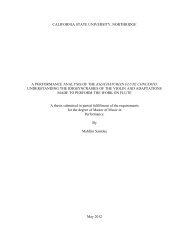2644 - CSUN ScholarWorks - California State University, Northridge
2644 - CSUN ScholarWorks - California State University, Northridge
2644 - CSUN ScholarWorks - California State University, Northridge
You also want an ePaper? Increase the reach of your titles
YUMPU automatically turns print PDFs into web optimized ePapers that Google loves.
2740<br />
Journal of Student Research Abstracts · 47<br />
THE EFFECTS OF CITRUS OIL ON THE REPRODUCTION OF DROSOPHILA<br />
MELANOGASTER.<br />
Jason Poon and Steve DeGusta (teacher). John F. Kennedy High School, 6715 Gloria Drive, Sacramento,<br />
CA 95831.<br />
The main objective of this investigation was to determine whether or not citrus oil, specifically orange citrus<br />
oil, was toxic to the reproduction of fruit flies Drosophila melanogaster. Therefore, a control group, four culture<br />
tubes filled with 10 ml of instant .drosophila medium, and an experimental group, four other culture tubes<br />
filled with 10 ml of instant drosophila medium as well as 2.5 g of finely diced orange peels, were used. The<br />
orange peels provided the tubes with the citrus oils needed to combine with the medium. Three female and three<br />
male VS Drosophila were added to each tube. After three weeks a count of the offspring was made to see if the<br />
citrus oils killed off some of the offspring, and the count resulted with 444 flies for the control group and 85<br />
flies for the experimental group. There was a highly significant difference between the control at)d the experimental<br />
(X 2 = 243.6, p < 0.001), thus proving that orange citrus oil was toxic to the reproduction of fruit flies.<br />
2741<br />
THE EFFECT OF BREAD MOLD'S GROWTH ON THE pH VALUE OF THE<br />
MEDIUM<br />
Eric Yeung and Steve DeGusta (teacher), John F. Kennedy High School, 6715 Gloria Drive, Sacramento,<br />
CA 95831.<br />
The purpose of this experiment is to test if bread mold's (Rhizopus nigricans) growth will cause an increase<br />
in the pH value of the medium that it grows on. I mixed Brom Thymol Blue indicator and vinegar with nutrient<br />
agar and used it as the medium for the bread mold to grow on. The vinegar gave the agar an initial color<br />
of yellow, indicating a pH value of about 6. Then I transferred bread mold aseptically to the agar for the experimental<br />
group of 20 petri dishes, while nothing was transferred to the 20 petri dishes of the control group. The<br />
petri dishes were observed for the next four days and the color of the agar in each petri dish was recorded. The<br />
color of agar in all of the control plates remained yellow indicating a pH value of about 6, while the color of<br />
agar in all of the experimental plates changed to blue indicating a pH value of about 7. According to the results<br />
of this investigation, I conclude that the growth of bread mold causes an increase in the pH value of the medium<br />
that it grows on.<br />
2742<br />
EFFECTS OF CONCENTRATION ON THE pH OF A PHOSPHATE BUFFER.<br />
G.J. Fornero, J.W. Lee, P. Porazik and B. Van Duzee. Saugus High School, 27900 West Centurion Way,<br />
Saugus, CA 91350.<br />
A phosphate buffer with neutral pH is one of the most commonly used reagents in biological studies. Proper<br />
preparation of such buffer with defined pH is essential for accurate and reproducible measurement for biological<br />
acitivities. To understand the concept of acid-base equilibration and how changes in concentration affects<br />
the pH of a buffer, we measured the pH of a series of increasingly diluted potassium phosphate buffer and compared<br />
the observed pH values to the calculated values. We prepared a 400 mM pH 6.8 solution and then diluted<br />
to 300, 200, 100, 50, 25 and 10 mM, respectively, with water. It was found that the pH of these serially diluted<br />
phosphate buffers are pH 6.80, 6.83, 6.89, 6.94, 7.02 and 6.99, respectively. In contrast, a calculation based<br />
on dilution alone predicts the pH to be 6.92, 7.10, 7.40, 7.70, 8.00, and 8.4 respectively. The slower than<br />
expected increase in the measured pH indicates that dilution of phosphate causes increases in proton concentration<br />
as the result of a shift in the acid-base equilibration towards the dissociation and release proton ions.













